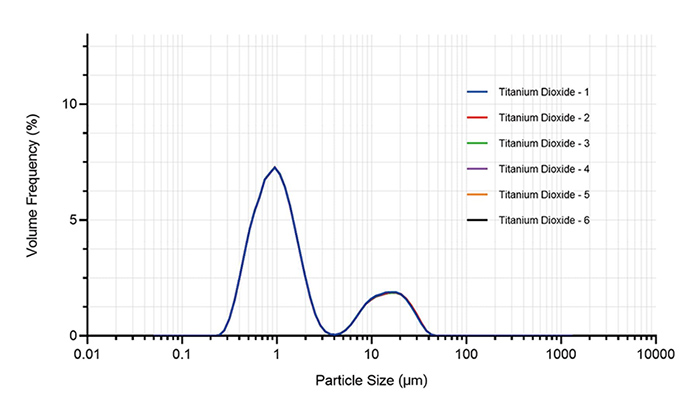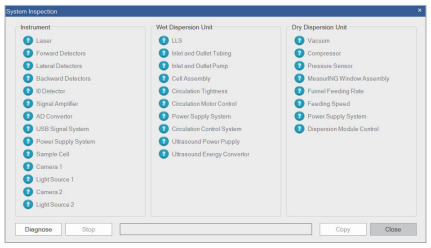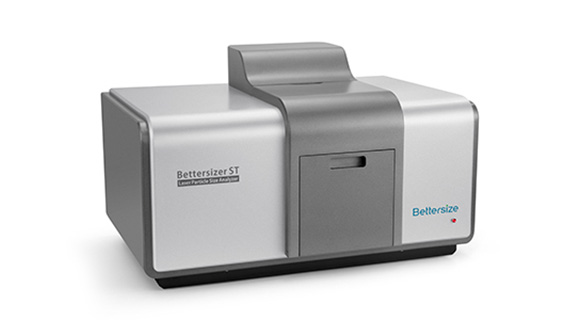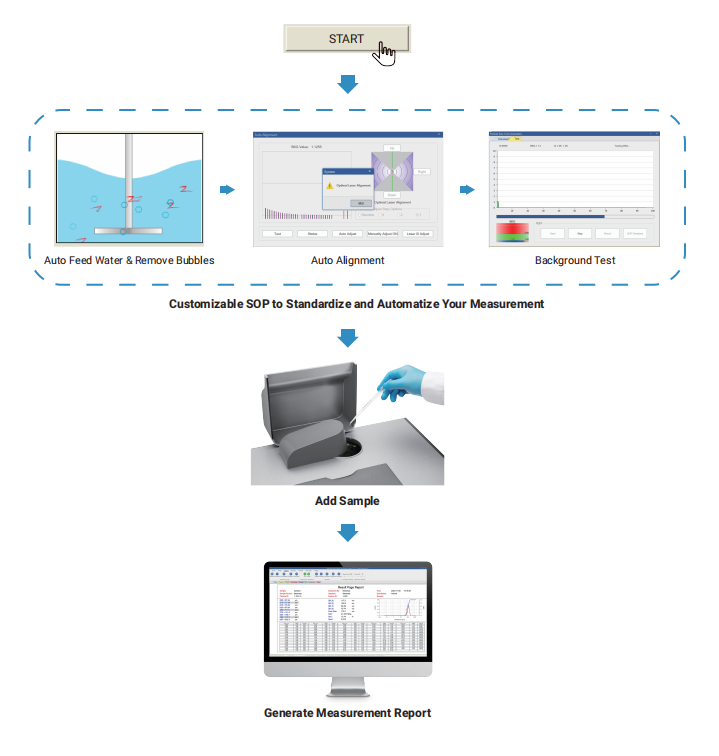Bettersizer ST는 산업용 품질 관리를 위한 자동화된 레이저 회절식 입도 분석기입니다. 특허받은 DLOS(Dual Lens Optical System) 기술을 적용하여 일관되고 신뢰할 수 있는 입도 분포 결과를 제공합니다. 또한, SOP(Standard Operating Procedure) 및 자동 분석 절차를 통해 품질 검사의 시간을 절약할 수 있도록 설계되었습니다.
특징 및 장점
- ● 분산 방식: 습식
- ● 측정 범위: 0.1 - 1,000µm
- ● 좋은 내구성
- ● 사용 용이
- ● 높은 비용 효율성
- ● 컴팩트한 디자인
- ● 유지보수 비용 저렴
- ● 듀얼 렌즈 시스템
- ● 자동 정렬 기능
- ● SOP에 따른 자동 측정 가능
동영상
How to Install and Operate Bettersizer ST 
Bettersizer ST Self-Installation is Quick and Easy 
Learn How Bettersizer ST can Help with Your Quality Control in 2 Minutes 
Bettersizer ST | Demo (CaCO3 Sample) 
Bettersizer ST Overview | Laser Diffraction Particle Size Analyzer for QC 
개요
특징
SOP
DLOS
기술
사양
Your One-Stop QC Tool
Bettersizer ST는 산업 품질 관리를 위해 설계된 자동 입도 분석기입니다. 특허 받은 DLOS (Dual Lens Optical System)가 정확하고 일관된 입도 분포 결과를 제공합니다. 표준 작업 절차 SOP (Standard Operating Procedure)와 자동 분석 기능 덕분에 품질 검사 시간을 절약할 수 있습니다.
1. Excellent Accuracy 뛰어난 정확도
♦ 표준물질로 정확도 검증
- Bettersizer ST는 Duke 표준 물질을 측정하여, 입도 분포 피크가 정확한 위치에 형성되었으며, 좁은 분포와 높은 정확도를 확인할 수 있었습니다.

- 빨간 선은 표준의 명목 크기 범위 ± 1.0%를 나타내며, 검은 점은 측정된 크기를 나타냅니다. 그림에서 보듯이, Bettersizer ST 레이저회절식 입도 분석기의 측정 정확도 편차는 1% 이내입니다.

2. 뛰어난 재현성 Repeatability
Bettersizer ST 레이저 입도 분석기는 반복 측정 시에도 안정적인 결과를 제공하여 신뢰도를 높입니다. 빠르고 정확한 측정으로 품질 관리 업무를 더욱 효율적으로 수행할 수 있습니다.
♦ 뛰어난 재현성을 갖은 이유
- 신호 전송 시스템의 높은 안정성
- 효율적인 분산 시스템
- 자동 정렬 기능으로 항상 최적의 상태 유지
- 초당 3,500회 신호 획득으로 정밀한 분석 가능
♦ 재현성 테스트 결과
연속적으로 수행한 두 번의 테스트에서도 Bettersizer ST는 변동 없이 일정한 결과를 보여주었습니다.
 |
 |
 |
 |
3. 업무 부담 최소화
Bettersize 소프트웨어는 다양한 기능을 제공하여 사용자의 업무 부담을 효과적으로 줄여줍니다.
1) 직관적인 소프트웨어 – 사용이 간편하고 쉽게 이해할 수 있는 인터페이스 제공
2) 지능형 데이터 평가 – 품질 관리를 위한 자동 데이터 분석 및 평가 기능 지원

3) 성능 검증
성능 검증 기능을 통해, 소프트웨어는 ISO 13320 및 의약품 기준을 준수하는 보고서를 자동으로 생성할 수 있습니다.

4) 시스템 점검
진단 스캔: 시스템 점검 체크리스트.
4. 비용 효율성 및 내구성
- 우수한 내구성
- 기기를 보호하는 견고한 하단판
- 내구성 테스트 후에도 정확한 측정 가능
- 긴 수명을 자랑하는 섬유 반도체 레이저 소스
- 내구성이 뛰어난 스테인리스 스틸로 제작된 순환 탱크
- 초음파 분산기의 드라이런 보호 기능
- 컴팩트한 디자인
- 실험실과 공장에서 소중한 공간을 절약할 수 있는 내부 습식 분산 시스템
- DLOS 시스템으로 정확한 결과를 보장하며, 잘못 정렬되는 광학 부품을 피함
- 간편한 유지 관리
- 샘플 셀을 쉽게 분리하여 빠르게 청소할 수 있으며, 전문 도구나 복잡한 청소 절차 없이도 손쉽게 접근 가능
- 순환 탱크의 자동 세척 기능으로 유지 관리가 간편
- 소프트웨어에서 자동 세척 프로세스를 쉽게 설정 가능
- 저렴한 유지비용
- 합리적인 가격으로 제공되는 레이저 입도 분석기
- DLOS 기술을 사용해 대부분의 애플리케이션에 적합한 측정 범위를 제공, 추가적인 레이저 소스 없이도 사용 가능
Citations
- Bettersizer 2600
Functional redundancy as an indicator for evaluating functional diversity of macrobenthos under the mussel raft farm near Gouqi Island
DOI: 10.1016/j.aquaculture.2023.740024 Read ArticleZhejiang Ocean University | 2024Biological traits analysis (BTA) helps to evaluate the effects of different environmental variables on the traits-based functional composition of macrobenthos. However, research on functional traits of macrobenthos under mussel farming is limited. We investigated the spatial and temporal response of the benthic system in terms of taxonomic and functional diversity to environmental variables of farming and natural stressors resulting from suspended mussel farming near Gouqi Island of eastern China Sea. The functional traits of macrobenthic assemblages under mussel farming were characterized by “medium adult body size”, “vermiform body form”, “high flexibility”, “infauna”, “semi-motile”, “gonochoristic”, “surface deposit-feeders”, “carnivores”, “semi-motile burrowers”, and “tube-dwellers”. Functional redundancy was stable in response to mussel farming stresses among seasons, whereas species diversity showed efficient to evaluate natural variables. Functional diversity was significantly affected by farming stressors rather than natural variables, Further analysis using multivariate methods together with continuous monitoring were highlighted to evaluate the impacts of mussel farming. Our results reinforce the importance of macrobenthic species and functional traits analysis to evaluate human stresses driven impacts in offshore ecosystems. By analysing the environmental variables with different sources, independently, we concluded the main effects of human pressures on macrobenthic community. Such distinction could be particularly effective to isolate variable environmental descriptors and evaluate their effects on functional diversity, making the current approach promising for the evaluation of ecological effects of anthropogenic stressors in aquaculture areas. - Bettersizer 2600
Degradation characteristics and utilization strategies of a covalent bonded resin-based solid amine during capturing CO2 from flue gas
DOI: 10.1016/j.seppur.2023.125621 Read ArticleChina University of Petroleum | 2024In this study, various types of degradation as well as attrition which are possibly encountered in a circulating fluidized bed temperature swing adsorption (CFB-TSA) process, were conducted experimentally to evaluate the stability of a resin-based solid amine sorbent. Other characterizations methods, such as elemental analysis (EA), Fourier transform infrared spectroscopy (FTIR) etc. were applied to further reveal the degradation mechanisms. The results showed that thermal degradation occurs from 140–160 °C due to the decomposition of amine group. The CO2-induced degradation occurs from a higher temperature of 160–180 °C accompanied by the production of urea. Hydrothermal stability is good below 130 °C, but the ionic impurities in steam crystalized on particle surface can accelerate the degradation. Oxidative degradation is the most harmful, which starts at a lower temperature of 70–80 °C with the formation of aldehyde. The existence of H2O in atmosphere can alleviate the oxidative and CO2-induced degradations. The employed sorbent has a very low attrition index of 0.05, which is 1–2 orders lower than typical commercial fluidized bed catalysts. Based on the results of stability evaluation, some design suggestions for proper utilization of this sorbent or other similar resin-based sorbents have been provided in an industrial CFB-TSA process.
- Bettersizer 2600
De-branching of starch molecules enhanced the complexation with chitosan and its potential utilization for delivering hydrophobic compounds
DOI: 10.1016/j.foodhyd.2023.109498 Read ArticleShihezi University | 2024The current study aimed to prepare the complexes between debranched-waxy corn starch and chitosan polymers (DBS-CS), and then investigated their corresponding structural characteristics, rheological property and potent application in Pickering emulsion. The results indicated that the existence of chitosan significantly inhibited starch short-range molecular rearrangement for all DBS-CS samples, which was manipulated by both debranching treatment and chitosan content. Interestingly, this is the first study to reveal that the outstanding peak at 1.8 ppm in 1H NMR spectrum for sample DBS-CS was gradually shifted towards a lower-field region following an increased chitosan content. Moreover, the debranching treatment shifted the crystallinity pattern from A-type to B-type and the relative crystallinity of DBS-CS decreased gradually with the increased content of CS. All samples had a pseudoplastic fluid and shear-thinning behavior with an enhanced shear resistance following the complexation. The DBS-CS was applied in a Pickering emulsion for showing a greater emulsifying stability and a lower gel strength than native NS-CS prepared emulsion. Importantly, the encapsulation ability of curcumin in the DBS-CS emulsion was significantly improved, followed by an increase of 15.45% for its corresponding bioavailability compared to the control. Therefore, this study might highlight a potential carrier for delivering the bioactive substances in a green pattern. - Bettersizer 2600
Heat-induced aggregation behavior of wheat gluten after adding citrus pectin with different esterification degree
DOI: 10.1016/j.foodhyd.2023.109420 Read ArticleGansu Agricultural University | 2024Wheat gluten aggregation during heat treatment is beneficial to the final quality of gluten-based products. Exogenous pectin can affect gluten aggregation. However, the effect of pectin with different degrees of esterification on the heat-induced aggregation behavior of gluten and its possible mechanism are still unclear. Thus, the heat-induced aggregation behavior of gluten after adding pectin with different esterification degree was studied in this study. When the temperature was raised from 25 °C to 95 °C, pectin affected gluten aggregation and was related to the degree of esterification. Specifically, the results of rheological properties and particle size indicated that low-ester pectin improved the viscoelasticity of gluten and promoted gluten aggregation. Thermal properties revealed that enthalpy of gluten added with low-ester pectin (37%) increased from 92.96 J/g to 95.40 J/g during heating process. Structurally, the fluorescence intensity and surface hydrophobicity of gluten added with low-ester pectin (37%) were lower than those added with high-ester pectin (73%). In addition, low-ester pectin (37%) significantly increased the disulfide bond content (from 15.31 μmol/g to 18.06 μmol/g) and maintained β-sheet content of gluten compared with gluten alone at 95 °C, indicating that low-ester pectin was more likely to induce gluten aggregation. However, scanning electron microscope showed that the gluten added with low-ester pectin (46%) exhibited a denser network structure at 95 °C than that added with low-ester pectin (37%). These results will provide a theoretical base for the regulation of gluten aggregation and the quality of gluten-based products by pectin with different esterification degree.
- 1
- 2
- 3
- 4
- 5
- 6
- 84
선별된 리소스
사용후기




















